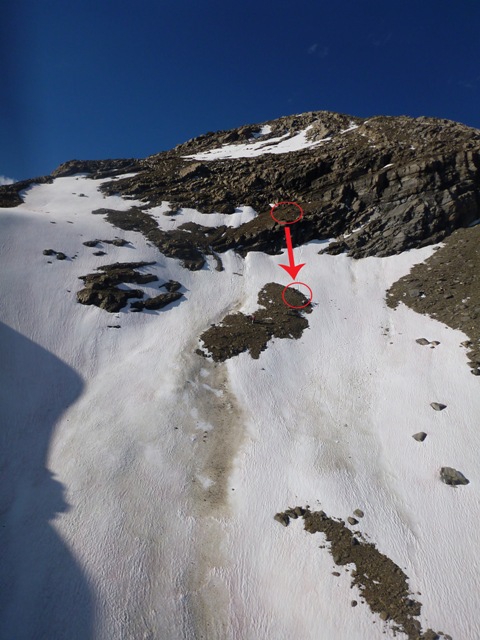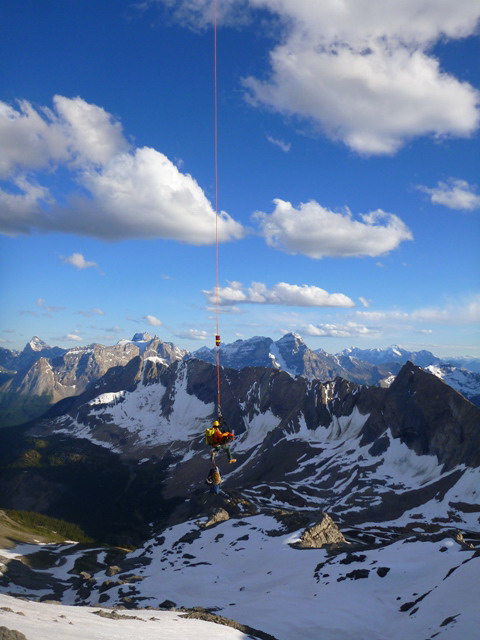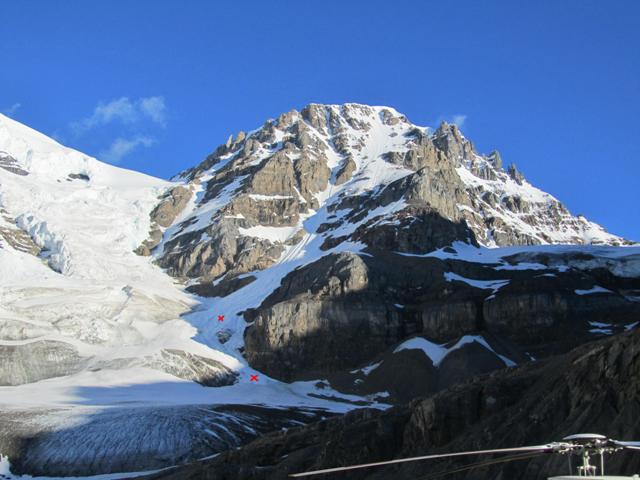Accident Reports - July 2011
Mountain safety
Cliff Jumping Accident, Fatal, Horseshoe Lake, Jasper National Park, July 31st, 2011
Fall while scrambling, Mount Niles, Yoho National Park, July 24th, 2011
Lead fall while sport climbing, Lauretta Slabs, Mt Revelstoke National Park, July 16, 2011
Stranded scrambler, Fernie Alpine Resort, July 9th, 2011
Avalanche Accident, Injured climbers, Mt. Diadem, Jasper National Park, July 6th, 2011
Cliff Jumping Accident, Fatal, Horseshoe Lake, Jasper National Park, July 31st, 2011
On July 31st, four friends in their mid-twenties, were at Horseshoe Lake on a hot summer afternoon. Horseshoe Lake is a popular cliff jumping location with cliffs ranging from 10 to 80 feet tall. J.B. decided to jump a 50’ cliff into the lake. With friends watching from the opposite shore, he jumped and hit his head on the cliff during the freefall. He did not surface. Friends responded by jumping in after him but were too late to intercept his sinking to the bottom. They could not locate him.
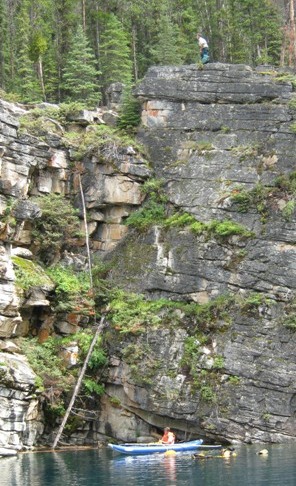
Parks Canada Visitor Safety Specialists at the scene of
the accident © Parks Canada
The friends continued to search for J.B. with one calling 911 for assistance. A Visitor Safety team was dispatched to the location. Wearing dry-suits and snorkel masks, a rescuer could faintly discern an outline of someone on the bottom 60’ down. Local volunteer fire department dive team were dispatched to assist while the on-site rescuers continued to try to retrieve him. A rescuer was able to hook his trunks with a large grapple hook and bring him to the surface. J.B. was transported to shore using an inflatable kayak to waiting medics where CPR was commenced. He was pronounced dead shortly later by a physician.
Analysis
Horseshoe Lake is popular for cliff jumpers especially on hot days. This activity is inherently dangerous for obvious reasons. The local hospital reports, on a nice day, it is common for numerous people to walk into the hospital complaining of injuries from jumping at Horseshoe Lake. It is uncertain why J.B. hit his head but many of the cliffs are not completely vertical making it imperative to get a running jump. He may have slipped just before leaping, or did not have enough momentum. J.B.’s head injury was either immediately fatal, or forced his rapid drowning due to his unconscious state. Youtube is a good source for “Horseshoe Lake bad landings”, further emphasising how a good time can quickly turn bad.
Fall while scrambling, Mount Niles, Yoho National Park, July 24th, 2011
At 1700, a group of 11 people were descending the scrambles route on the west ridge of Mount Niles. On the descent, one of the party members fell and tumbled 100 metres over steep broken terrain. The patient sustained injuries to her left arm and chest area. She did not lose consciousness, nor did she have difficulty breathing. The party was able to talk to the person at the trailhead via radio who then contacted 911.
The accident scene. The circles show the subject’s fall. © Parks Canada
Three Visitor Safety (VS) Specialists responded to the area in a helicopter. Another VS Specialist established a staging area at the Sherbrooke Lake Trailhead, and Banff EMS were dispatched.
The patient was packaged and slung off the mountain and then passed on to EMS. Due to the lateness of the day, the rest of the party was transported to the trailhead via helicopter.
A Parks Canada Visitor Safety Specialist heli-slings the injured subject to
the staging area. © Parks Canada
Analysis
Scrambling and mountaineering can be dangerous activities. It is essential to have proper training and equipment, and gradually build personal experience in order to stay safe. This group consisted of a variety of people of various experience levels. Some people had appropriate equipment for the climb (mountaineering boots, crampons and ice axe), and others did not.
The subject was lucky to survive such a fall. This positive outcome was aided by the amount of snow on the scree slope where she landed, which helped cushion her fall. During a typical summer season, this slope would have been snow free by the end of July. Finally, the group was organized enough to have a communications plan which enabled the Visitor Safety team to quickly come to the rescue.
Lead fall while sport climbing, Lauretta Slabs, Mt Revelstoke National Park, July 16, 2011
A couple were enjoying one of the first sunny days of the summer, sport climbing at an area known as Lauretta Slabs. At approximately 1500hrs, while leading the third pitch on a route called Priority Post, a hold pulled off, causing the climber to fall an estimated 10m. The climber landed on his feet on the slab and immediately knew he was injured. Unable to weight bear on his right ankle, and barely able to tolerate pressure on his left, his belayer lowered him to the belay ledge to assess the situation. The climbers had cell service and were able to call 911 requesting a rescue. After calling for help, the two climbers continued descending the route, lowering and rappelling to the base of the cliff where they waited for assistance.
Not knowing that Lauretta Slabs are within a national park, the dispatchers at 911 notified the local Revelstoke Search and Rescue (SAR) group. The call was passed on by a SAR member to Mount Revelstoke National Park's on-call Visitor Safety (VS) Specialist, stationed in Rogers Pass. Although the climbers had made it to the bottom of the cliff, the approach to Lauretta slabs involves hiking up steep, loose switchbacks and then through a large boulder field. The nature of the terrain meant that a ground evacuation with a wheeled stretcher would be difficult and even dangerous for the patient. The decision was made that a helicopter sling rescue was the best option for evacuating the injured climber.
Two VS Specialists responded from Lake Louise with a rescue helicopter and pilot, while the local VS Specialist and another Parks Canada staff member drove down from Rogers Pass to secure the staging area below the site. Meanwhile, an ambulance had arrived at the trailhead and one of the attendants was able to run up to the site and assess the patient, reporting that the climber was conscious and had suspected fractures to his right heel and left ankle. At 1730, two VS Specialists were heli-slung up to the site. Due to the size of his fall, the Specialists were concerned that he may have also sustained spinal injuries. The climber was packaged on a "scoop stretcher" spineboard and a "baumann bag" used for helicopter sling rescues, and flown down with a rescuer to the staging area where he was transferred to the ambulance.
Analysis
This incident reinforces two key points:
- Having knowledge of self-rescue systems is critical. This group was able to get themselves to a location where rescuers could safely assess and package the injured climber.
- Have a means of communication with you. Know where you get cell service. The second part to this point is knowing who to call and where you are. In this instance the call initially went to the local SAR group which resulted in a delay in the rescue.
Stranded scrambler, Fernie Alpine Resort, July 9th, 2011
A young man was descending loose and vertical terrain from the peak above the Fernie ski area and came to a spot where he could go no further. He was uninjured but stuck above a 50 meter vertical wall with a steep snow slope below. At approximately 19:50 hours the Parks Canada Visitor Safety rescue leader (based in Banff) received a call from the Elk Valley RCMP . The RCMP indicated they needed assistance with a helicopter long line rescue on the alpine wall above the Fernie Ski Area. The rescue leader questioned the RCMP about the situation. After the questioning, it was apparent to the rescue leader that immediate action needed to be taken; especially given the amount of daylight left, (approx 2 hours) and flight time between Banff and Fernie. Based on the time calculation made by the rescue leader, it was determined that there was approx 20 to 30 min to perform the rescue. By 20:15, the Parks Canada Visitor Safety Specialists were taking off from Banff with the necessary equipment. By 21:20, Parks Canada was in radio contact with the Elk Valley RCMP, Fernie Search and Rescue and Ascent Helicopters.
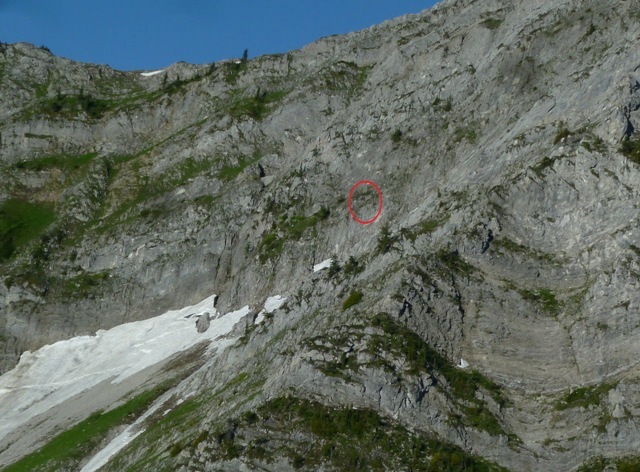
The scene of the rescue. The red circle shows the location of the stranded scrambler.
© Parks Canada
Parks Canada was updated that the situation and weather had not changed and the young man was still clung to the side of the alpine wall. The Parks Canada team immediately did a reconnaissance flight to do a weather and power check. It was also asserted that the subject would not be able to maintain his position, clung to the side of the wall, for much longer. A plan was formulated inside the helicopter between the two Visitor Safety Specialists and the pilot. One rescuer connected to the long line under the helicopter and was taken towards the rescue location. The pilot had to position the helicopter within 8 meters of the wall to accurately place the rescuer close to the stranded subject. After one attempt to be placed directly beside the subject, the rescuer radioed up to the pilot and explained that it was too unstable for him to unhook from the line in that location. A second location had to chosen. The rescuer then indicated that a ledge with a tree up and to the left of the subject would be adequate. The pilot then gently repositioned the helicopter to allow the rescuer to be relocated to the better area to unhook. The rescuer then unhooked while the helicopter orbited, waiting for the call to come back for the rescuer and subject. Meanwhile the rescuer on scene had to secure an anchor and throw a loop of rope to the subject to place over his shoulders.
The terrain was too steep and loose for the rescuer to access the subject on foot. Using rope techniques (belaying), the rescuer then brought the subject to his position. The rescuer then placed the subject inside a special suit that could be hooked into the helicopter long line. Time was running out, so after a reconfiguration of the anchor, the rescuer created a releasable system because the terrain was too steep to remain unattached to the wall for any period of time. He then called for the helicopter to come back, clipped himself and the subject onto the line and then quickly released from the mountain. The visibility for the pilot was very challenging at this point in time because of the fast approaching darkness. The rescuer and subject were placed safely at the staging area just minutes before nightfall.
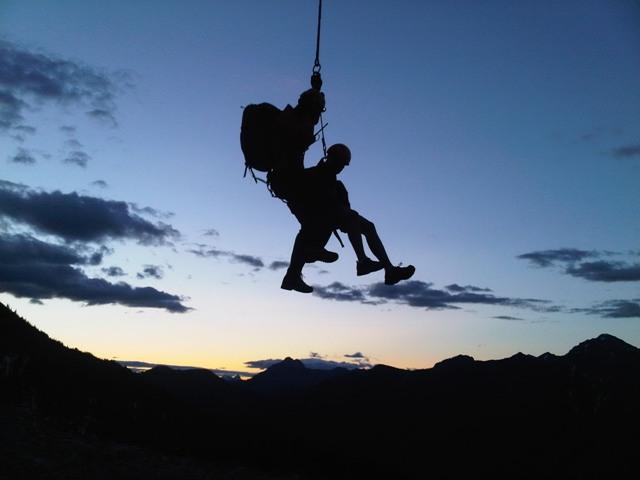
Parks Canada Visitor Safety Specialists heli-slinging as darkness falls © Parks Canada
Analysis
Quite often people are tempted to take short cuts through steep terrain, especially while descending. In this case, the subject was persistent in going down through semi technical terrain, and did not retrace his footsteps. At the point of becoming stuck, the subject did have the sense to stop and call for help. When faced with a situation like this, it is better to go back the way you came rather than forcing terrain that is becoming increasingly steeper.
Avalanche Accident, Injured climbers, Mt. Diadem, Jasper National Park, July 6th, 2011
On July 5th, 2 climbers, D.T. and K.D., hiked to Mt Diadem’s Southeast face to camp and climb the route the following day. The weather was sunny and warm. They noted several natural large loose avalanches while hiking to the site. The next morning, they left camp at 0500hrs under warm sunny conditions. They climbed the route to 50m below the summit where they decided to retreat since they encountered a large cornice at the top; as well, other areas had begun to avalanche.
At approximately 1500hrs, the 2 climbers were most of the way down when they were caught in a significantly large moist avalanche, approximately 50cm deep and 150m wide. It carried and tumbled them for 200m breaking the 8.2mm rope connecting them. They came to rest on top of the debris. K.D. had severe pain in his lower back, ankle, and knee. D.T. had pain in his forearm and knee. K.D., in pain, could walk slowly making his way back to their camp. D.T., being more mobile, walked out to the highway to request an evacuation.
Upon arriving at the highway, he realized that he had left his keys in the tent so he had to hitch a ride. He stopped at Sunwapta station and knocked on a few doors but no one was present. Continuing onto Jasper townsite, he arrived at the RCMP station at 2030hrs to report the incident. The last observation reported by D.T. of K.D. was that he was limping slowly to their camp. With failing light and deteriorating weather, a helicopter response was not possible. D.T. was checked at the hospital and released with knee strain and rope burns to his forearm where the rope had wrapped and broke. The following morning, Visitor Safety staff flew in at first light evacuating K.D. who had made it to his tent. K.D. was released from the hospital the same day with ankle and knee sprains plus bruises on his lower back where his harness likely rode up when the rope broke.
South Face of Mt Diadem © Parks Canada / G. Lemke
Analysis
D.T. and K.D. both mentioned that they started too late for their objective and conditions, plus they did not give enough weight to the natural avalanches they observed during the hike. They also picked a route with a large cornice at the top and retreated from their high point when they observed other avalanches nearby. By this time it was too late and they had to descend the South facing slope. D.T. also passed several pay-phones on his way to town.
In retrospect, the party had the proper gear yet made some critical errors such as not starting earlier, adjusting their plans accordingly based on conditions, anticipating how weather conditions would change snow conditions and climbing a route with an overhead cornice hazard. Also having an emergency plan such as where nearest phones are located, who to call, carrying a communication device, and leaving spare keys with the vehicles may have facilitated the evacuation of K.D. a lot sooner. It appeared the avalanche was initiated by a cornice failure at the top of the climb.
Accident Reports
Related links
- Date modified :
